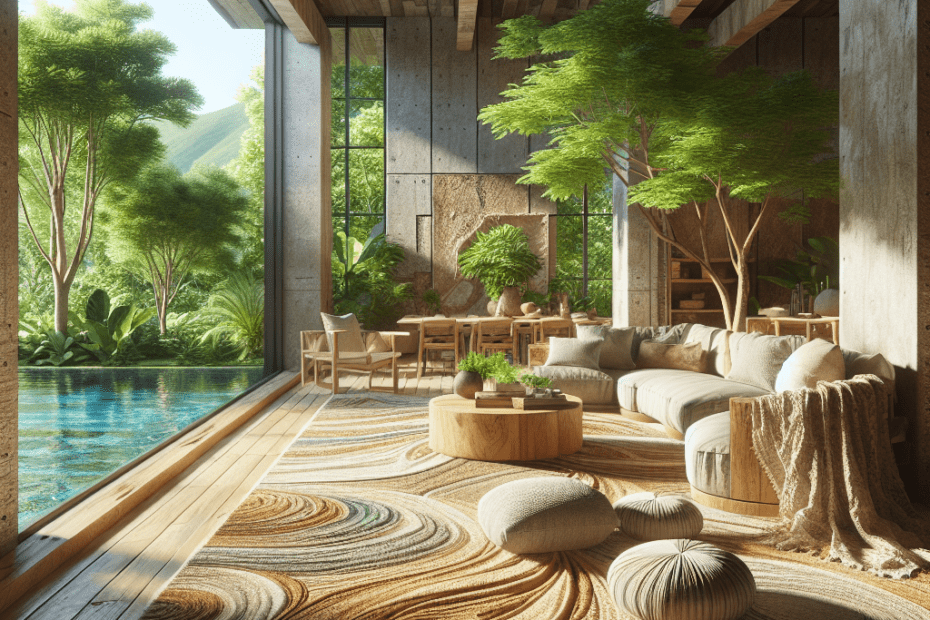“`html
Designing a home that merges seamlessly with its natural surroundings can create an enduring sense of tranquility and warmth. When homeowners wish to achieve this effect, they often incorporate earthy textures in design. These textures not only bring a tactile quality to a space but also contribute to an aesthetic that’s both calming and inviting.
Many people today are stepping away from the overly slick, minimalist styles and returning to designs that embrace natural elements. A survey by the Home Improvement Research Institute reveals that 54% of homeowners prefer using natural materials and textures in their home renovations (source: Home Improvement Research Institute, 2022). Earthy textures in design are gaining popularity for their capability to evoke the beauty of the outdoors and their ability to ground a space in authenticity and warmth.
The Essence of Earthy Textures
Earthy textures bring the raw, unrefined beauty of the natural world inside the living space. These textures can be found in materials such as wood, stone, leather, and clay. They echo the diversity of nature and are characterized by organic shapes and irregular patterns that reflect the spontaneity of the environment. Elements like exposed brick walls or unpolished wooden beams add depth to a room and invoke a sense of connection with nature.
Materials & Implementation
To achieve this nature-inspired home design, homeowners can incorporate a variety of materials:
- Wood: Reclaimed wood or live-edge furniture pieces provide warmth and texture, while also promoting sustainability. Wooden panels on walls or ceilings can create a rustic yet sophisticated atmosphere.
- Stone: Natural stone in the form of flooring, countertops, or decorative accents such as stone vases instantly adds an earthy feel. Stones like travertine or slate have unique textures that contribute to a genuine natural look.
- Clay and Terracotta: These materials add a touch of warmth and can be used in various decorative elements like pottery, tiles, or sculptures. They hold history and tradition, enriching the space with their organic allure.
- Textiles: Earthy textures can be echoed in textiles using woven materials like cotton, wool, or jute. Rugs, curtains, or cushions made from these materials can soften the hard textures and bring a cozy atmosphere.
Benefits of Earthy Textures
Incorporating earthy textures in design goes beyond mere aesthetics. There are psychological and functional benefits that make them a cherished choice among designers:
| Benefit | Description |
|---|---|
| Calming Effect | Natural textures tend to create a calming environment by evoking the serene vistas of the outdoors. |
| Sustainability | Using natural materials often involves sustainable practices, reducing the carbon footprint. |
| Durability | Many earthy materials, like stone and hardwood, are extremely durable and age gracefully, reducing the need for replacements. |
| Versatility | These materials blend seamlessly with various styles, from modern to rustic. |
| Improved Air Quality | Natural materials like wood and clay can improve air quality by regulating humidity and reducing toxins. |
Integrative Design and Harmony
For a truly cohesive design, it’s crucial to balance earthy textures with complementary colors and other design elements. Neutral tones and a muted color palette enhance the natural textures and help create a soothing visual harmony. Plants can further enhance this effect, adding splashes of green and softening harder lines with organic shapes. A circular woven rug or a pair of clay plant pots can also add subtle depth and texture to a space that invites exploration.
Key Takeaways
- Earthy textures in design are ideal for creating a nature-inspired home.
- These textures include materials like wood, stone, clay, and textiles.
- Benefits include a calming effect, sustainability, durability, versatility, and improved air quality.
- Balance textures with neutral tones and complementary design elements for a cohesive look.
FAQ
- What are some common materials used for earthy textures in design?
Common materials include wood, stone, clay, leather, and natural textiles like wool and cotton. - Why are earthy textures becoming popular in home design?
They provide a connection to nature, promote sustainability, and create a calming environment. - How can I incorporate earthy textures without a major renovation?
Consider adding elements like wooden furniture, stone accent pieces, or woven textiles to existing spaces. - Are earthy textures suitable for all types of homes?
Yes, they offer versatility and can complement a wide range of design styles from modern to rustic. - What colors work best with earthy textures?
Neutral tones and muted colors generally complement earthy textures, enhancing their natural beauty.
“`
This blog post is designed to provide homeowners with inspiration for using earthy textures to create a nature-inspired home, using simple, easily understood language and helpful tips.
